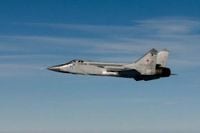In the tense autumn of 2025, the skies over Eastern Europe have become a high-stakes chessboard, with Russia’s unprecedented airspace incursions pushing NATO to the edge of a potential direct conflict. Over the course of September, a series of brazen Russian drone and fighter jet violations have rattled the alliance, forcing leaders on both sides of the Atlantic to confront uncomfortable questions about deterrence, unity, and the cost of defending Europe’s borders.
According to reporting from AP, the escalation began in early September when nearly two dozen Russian drones entered Polish airspace, marking the first time in NATO’s 76-year history that allied jets engaged enemy targets over a member’s territory. The incident triggered a scramble of NATO fighter jets, with Dutch F-35s using air-to-air missiles—costing between €400,000 and €1.7 million apiece—to shoot down Russian Geran drones, each worth less than €50,000. The economic imbalance was not lost on observers: defending against these low-cost provocations is a costly endeavor for NATO, one that could divert resources from supporting Ukraine’s war effort.
The drone swarm over Poland on September 10 was just the beginning. In the days that followed, Russian fighter jets lingered in Estonian airspace for 12 minutes with their transponders off—an act Estonia’s foreign minister called “unprecedently brazen,” as reported by Axios. Meanwhile, single Russian drones violated Romanian and Latvian airspace, and suspected Russian drones caused flight suspensions at airports in Denmark and Norway. Norway, which hadn’t seen such incidents in over a decade, reported three separate violations this year alone. The Polish Prime Minister, Donald Tusk, didn’t mince words: “Poland would, without discussion, shoot down any object that flies into its territory.”
These provocations have forced NATO and the EU to bolster air defenses along their eastern flank, with new operations and contingency plans rapidly put in place. Estonia, for example, has begun constructing miles of anti-tank trenches, while France and Germany have ordered preparations to treat thousands of wounded per day, according to Axios. NATO Secretary-General Mark Rutte emphasized that any decision to fire on intruding aircraft would be based on “available intelligence regarding the threat posed by the aircraft.”
But the alliance’s response has revealed cracks. As The Economist reported, the events of September exposed diverging appetites for risk among NATO’s 32 member states. While frontline countries like Poland and Estonia demand robust action, others—such as France—advocate for strengthening rules of engagement but stop short of endorsing the downing of Russian jets. French Foreign Minister Jean-Noël Barrot told Axios that France would “probably not go as far as shooting a plane” that crossed into NATO airspace. This hesitation is precisely what some analysts believe the Kremlin is seeking to exploit.
Experts like Mark Galeotti of Mayak Intelligence argue that these incursions are part of a “coercive signaling” campaign by Moscow, designed to test the alliance’s willingness to respond and to probe for weaknesses. “This is Moscow trying to say, ‘Just look how dangerous things already are and how dangerous they could get. Remember we are more daring, willful, reckless, resolute—use whatever adjective you want, but the point is, we are more of it,’” Galeotti said on a podcast, as cited by AP.
Edward Lucas, senior fellow at the Center for European Policy Analysis, echoed this sentiment, writing that “Russia does not need to defeat NATO militarily if it can defeat it politically. If alliance members do not believe that other members will come to their aid when they are attacked, they feel isolated.” The Kremlin’s strategy, then, is not merely about gathering intelligence on NATO’s air defense capabilities—though each incursion yields valuable data about reaction times and engagement procedures—but about sowing division and imposing costs that could sap the alliance’s resolve.
The political backdrop is no less fraught. After his meeting with U.S. President Donald Trump in Alaska in August, Russian President Vladimir Putin appeared emboldened, intensifying his so-called “grey-zone” campaign against NATO. Trump’s initial reaction to the drone incursion—suggesting it “could have been a mistake”—drew sharp rebukes from European leaders. Yet, by late September, Trump had shifted his stance, affirming that NATO should shoot down intruding Russian aircraft. Still, he demurred when asked if the U.S. would back the alliance in such a scenario, a hesitation that did not go unnoticed in Moscow or among NATO’s eastern members.
Ukrainian President Volodymyr Zelensky, speaking to Axios, was blunt in his assessment: “They have to shoot down everything. If the jets are in your space, you have to block it.” He added that while not all NATO leaders were afraid to take such action, most are, because they think “Russia is crazy”—and, in his words, “they are right.”
The Kremlin, for its part, has issued stark warnings. After Trump’s comments, Russian officials declared that shooting down a Russian jet would lead to war. Dmitry Medvedev, one of Putin’s hardline lieutenants, threatened that Russia possesses weapons “a bomb shelter won’t protect against,” a chilling reminder of the nuclear overtones that shadow every escalation.
Behind the bluster, however, lies a calculated strategy. By forcing NATO to spend heavily on air defense—each missile fired at a drone is a costly decision—Russia hopes to divert resources away from Ukraine and expose gaps in the alliance’s integrated air and missile defense. As The Economist noted, “If Russian actions lead NATO to over-prioritize investments in air defense, it will leave them with fewer resources to spend on long-range weapons that can cause damage and deter Russia from escalating to war.”
The absence of strong American political leadership in NATO, highlighted by the European Council on Foreign Relations, has only exacerbated these challenges. Without the U.S. keeping a lid on intra-European misalignments, it’s become harder for European countries to coalesce around a common response. Some experts suggest that a show of multinational resolve—perhaps a large-scale exercise involving British, French, Dutch, Australian, and Japanese forces—could send a powerful signal to Moscow that the alliance’s unity is not easily broken.
As September draws to a close, both sides appear to be preparing for the unthinkable. NATO’s eastern members are fortifying their defenses, and alliance-wide discussions continue about how best to respond to future provocations. But with peace talks frozen and nuclear threats flying, the risk of miscalculation looms large. As Russian Foreign Minister Sergey Lavrov declared at the United Nations, NATO and Moscow are already “at war”—a chilling assessment that, for now, remains confined to words and warnings, but could spill over if the next drone or jet crosses the wrong line.
For now, the skies over Eastern Europe remain a flashpoint, with each new incursion testing not only radars and missiles, but the very fabric of NATO itself.






